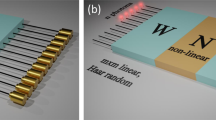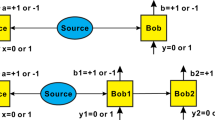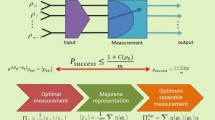Abstract
Quantum coherence is a useful resource that is consumed to accomplish several tasks that classical devices are hard to fulfill. Particularly, it is considered to be the origin of quantum speedup for many computational algorithms. In this work, we interpret the computational time cost of boson sampling with partially distinguishable photons from the perspective of coherence resource theory. With incoherent operations that preserve the diagonal elements of quantum states up to permutation, which we name permuted genuinely incoherent operation, we present some evidence that the decrease of coherence corresponds to a computationally less complex system of partially distinguishable boson sampling. Our result shows that coherence is one of crucial resources for the computational time cost of boson sampling. We expect our work presents an insight to understand the quantum complexity of the linear optical network system.


Similar content being viewed by others
Notes
This can be compared to the coherence theory of wave–particle duality in multi-slit experiments [21,22,23, 41]. These researches showed that the interference phenomena (wave-like property) of a quanton through a multi-slit path increases as the degree of coherence increase, which is analogous to our case with multimode linear optical network.
References
Aaronson, S., Arkhipov, A.: The computational complexity of linear optics. In: Proceedings of the Forty-Third Annual ACM Symposium on Theory of Computing, pp. 333–342. ACM (2011)
Töppel, F., Aiello, A., Leuchs, G.: All photons are equal but some photons are more equal than others. N. J. Phys. 14(9), 093051 (2012)
Tan, S.-H., Gao, Y.Y., de Guise, H., Sanders, B.C.: Su (3) quantum interferometry with single-photon input pulses. Phys. Rev. Lett. 110(11), 113603 (2013)
Tillmann, M., Tan, S.-H., Stoeckl, S.E., Sanders, B.C., de Guise, H., Heilmann, R., Nolte, S., Szameit, A., Walther, P.: Generalized multiphoton quantum interference. Phys. Rev. X 5(4), 041015 (2015)
de Guise, H., Tan, S.-H., Poulin, I.P., Sanders, B.C.: Coincidence landscapes for three-channel linear optical networks. Phys. Rev. A 89(6), 063819 (2014)
Rohde, P.P.: Boson sampling with photons of arbitrary spectral structure. Phys. Rev. A 91(1), 012307 (2015)
Tamma, V., Laibacher, S.: Multiboson correlation interferometry with multimode thermal sources. Phys. Rev. A 90(6), 063836 (2014)
Tamma, V.: Sampling of bosonic qubits. Int. J. Quantum Inf. 12(07n08), 1560017 (2015)
Shchesnovich, V.S.: Sufficient condition for the mode mismatch of single photons for scalability of the boson-sampling computer. Phys. Rev. A 89(2), 022333 (2014)
Shchesnovich, V.S.: Partial indistinguishability theory for multiphoton experiments in multiport devices. Phys. Rev. A 91(1), 013844 (2015)
Tichy, M.C.: Sampling of partially distinguishable bosons and the relation to the multidimensional permanent. Phys. Rev. A 91(2), 022316 (2015)
Renema, J.J., Menssen, A., Clements, W.R., Triginer, G., Kolthammer, W.S., Walmsley, I.A.: Efficient classical algorithm for boson sampling with partially distinguishable photons. Phys. Rev. Lett. 120, 220502 (2018)
Baumgratz, T., Cramer, M., Plenio, M.B.: Quantifying coherence. Phys. Rev. Lett. 113(14), 140401 (2014)
Streltsov, A., Adesso, G., Plenio, M.B.: Colloquium: quantum coherence as a resource. Rev. Mod. Phys. 89(4), 041003 (2017)
Chitambar, E., Gour, G.: Quantum resource theories. Rev. Mod. Phys. 91(2), 025001 (2019)
de Vicente, J.I., Streltsov, A.: Genuine quantum coherence. J. Phys. A Math. Theor. 50(4), 045301 (2016)
Yadin, B., Ma, J., Girolami, D., Mile, G., Vedral, V.: Quantum processes which do not use coherence. Phys. Rev. X 6(4), 041028 (2016)
Yung, M.-H., Gao, X., Huh, J.: Universal bound on sampling bosons in linear optics and its computational implications. Natl. Sci. Rev. 6(4), 719–729 (2019)
Chin, S., Huh, J.: Majorization and the time complexity of linear optical networks. J. Phys. A Math. Theor. 52(24), 245301 (2019)
Chin, S., Huh, J.: Generalized concurrence in boson sampling. Sci. Rep. 8, 6101 (2018)
Bera, M.N., Qureshi, T., Siddiqui, M.A., Pati, A.K.: Duality of quantum coherence and path distinguishability. Phys. Rev. A 92(1), 012118 (2015)
Bagan, E., Bergou, J.A., Cottrell, S.S., Hillery, M.: Relations between coherence and path information. Phys. Rev. Lett. 116(16), 160406 (2016)
Chin, S.: Generalized coherence concurrence and path distinguishability. J. Phys. A Math. Theor. 50(47), 475302 (2017)
Aberg, J.: Quantifying superposition. arXiv:quant-ph/0612146 (2006)
Winter, A., Yang, D.: Operational resource theory of coherence. Phys. Rev. Lett. 116(12), 120404 (2016)
Hillery, M.: Coherence as a resource in decision problems: the Deutsch–Jozsa algorithm and a variation. Phys. Rev. A 93, 012111 (2016)
Shi, H.-L., Liu, S.-Y., Wang, X.-H., Yang, W.-L., Yang, Z.-Y., Fan, H.: Coherence depletion in the grover quantum search algorithm. Phys. Rev. A 95, 032307 (2017)
Chin, S.: Coherence number as a discrete quantum resource. Phys. Rev. A 96(4), 042336 (2017)
Chitambar, E., Gour, G.: Comparison of incoherent operations and measures of coherence. Phys. Rev. A 94(5), 052336 (2016)
Chitambar, E., Gour, G.: Critical examination of incoherent operations and a physically consistent resource theory of quantum coherence. Phys. Rev. Lett. 117(3), 030401 (2016)
Gour, G., Marvian, I., Spekkens, R.W.: Measuring the quality of a quantum reference frame: the relative entropy of frameness. Phys. Rev. A 80(1), 012307 (2009)
Marvian, I., Spekkens, R.W.: How to quantify coherence: distinguishing speakable and unspeakable notions. Phys. Rev. A 94(5), 052324 (2016)
Marvian, I., Spekkens, R.W.: Extending Noether’s theorem by quantifying the asymmetry of quantum states. Nat. Commun. 5, 3821 (2014)
Marvian, I., Spekkens, R.W., Zanardi, P.: Quantum speed limits, coherence, and asymmetry. Phys. Rev. A 93(5), 052331 (2016)
Mandel, L.: Coherence and indistinguishability. Opt. Lett. 16(23), 1882–1883 (1991)
Marvian, I., Spekkens, R.W.: The theory of manipulations of pure state asymmetry: I. Basic tools, equivalence classes and single copy transformations. N. J. Phys. 15(3), 033001 (2013)
Walschaers, M., Kuipers, J., Buchleitner, A.: From many-particle interference to correlation spectroscopy. Phys. Rev. A 94(2), 020104 (2016)
Brünner, T., Dufour, G., Rodríguez, A., Buchleitner, A.: Signatures of indistinguishability in bosonic many-body dynamics. Phys. Rev. Lett. 120(21), 210401 (2018)
Lloyd, S.: Quantum search without entanglement. Phys. Rev. A 61(1), 010301 (1999)
Stahlke, D.: Quantum interference as a resource for quantum speedup. Phys. Rev. A 90(2), 022302 (2014)
Biswas, T., Díaz, M.G., Winter, A.: Interferometric visibility and coherence. Proc. R. Soc. A Math. Phys. Eng. Sci. 473(2203), 20170170 (2017)
Ryser, H.J.: Combinatorial Mathematics. The Carus Mathematical Monographs, vol. 14. Wiley, New York (1963)
Bai, Z., Du, S.: Maximally coherent states. arXiv:1503.07103 (2015)
Jerrum, M., Sinclair, A., Vigoda, E.: A polynomial-time approximation algorithm for the permanent of a matrix with nonnegative entries. J. ACM 51(4), 671–697 (2004)
Lund, A.P., Laing, A., Rahimi-Keshari, S., Rudolph, T., O’Brien, J.L., Ralph, T.C.: Boson sampling from a Gaussian state. Phys. Rev. Lett. 113(10), 100502 (2014)
Rahimi-Keshari, S., Lund, A.P., Ralph, T.C.: What can quantum optics say about computational complexity theory? Phys. Rev. Lett. 114, 060501 (2015)
Rahimi-Keshari, S., Ralph, T.C., Caves, C.M.: Sufficient conditions for efficient classical simulation of quantum optics. Phys. Rev. X 6(2), 021039 (2016)
Huh, J., Yung, M.-H.: Vibronic boson sampling: generalized Gaussian boson sampling for molecular vibronic spectra at finite temperature. Sci. Rep. 7(1), 7462 (2017)
Hamilton, C.S., Kruse, R., Sansoni, L., Barkhofen, S., Silberhorn, C., Jex, I.: Gaussian boson sampling. Phys. Rev. Lett. 119(17), 170501 (2017)
Gurvits, L., Samorodnitsky, A.: Bounds on the permanent and some applications. In: 2014 IEEE 55th Annual Symposium on Foundations of Computer Science (FOCS), pp. 90–99. IEEE (2014)
Acknowledgements
Jelmer Renema presented some heplful comments while amending this work. S.C. is grateful to Prof. Jung-Hoon Chun for his support. S.C. is supported through the National Research Foundation of Korea (NRF) funded by the Ministry of Education (NRF-2019R1I1A1A01059964). J.H is suppored through the National Research Foundation of Korea (NRF) funded by the Ministry of Education, Science and Technology (NRF-2015R1A6A3A04059773, NRF-2019M3E4A1080227, NRF-2019M3E4A1079666), and POSCO Science Fellowship of POSCO TJ Park Foundation.
Author information
Authors and Affiliations
Corresponding author
Additional information
Publisher's Note
Springer Nature remains neutral with regard to jurisdictional claims in published maps and institutional affiliations.
Seungbeom Chin and Joonsuk Huh are contributed equally to this work.
Appendices
The upper bound of transition probability with \({\text {perm}}(|{\mathcal {S}}|)\)
A slight modification of Eq. (51) in Ref. [11] gives
where the inequality comes from the relation \(\big |{\text {perm}}(V\odot V^*_{\mathbb {I},\sigma } ) \big | \le {\text {perm}}(V\odot V^*)\equiv P_{\mathbb {I}}\) for any permutation \(\sigma \). Using the monotonicity of \({\text {perm}}(|{\mathcal {S}}|)\) from Theorem 3, we can see that a pGIO on \({\mathcal {S}}\) decreases the upper bound of the transition probability \(P({\vec {n}},{\vec {m}})\). The unitarity condition of V in Eq. (15) provides a more rigorous upper bound condition for the equation. Indeed, since \(V\odot V^*\) is a unistochastic matrix (a doubly stochastic matrix whose elements are the absolute squares of the elements of a unitary matrix), the upper and lower bounds for \(P_{\mathbb {I}} = {\text {perm}}(V\odot V^*)\) are given using the result in Ref. [50] by
where \(F(V\odot V^*) \equiv \prod _{i,j=1}^N(1-|V_{ij}|^2)^{1-|V_{ij}|^2 }\). Hence, Eq. (15) can be rewritten as
Alternative algorithm example
(\(N=4\)) The runtime using Eq. (12) is \((2^{6}4^3)/2=2048\). However, when \(S_{13}=S_{24}=S_{34}=0\), the summations with the following (R, S) become zero:
which contains 4, 4, 8, and 8 terms, respectively. Therefore, the resulting runtime decreases to 2024.
Rights and permissions
About this article
Cite this article
Chin, S., Huh, J. Partial distinguishability as a coherence resource in boson sampling. Quantum Inf Process 19, 37 (2020). https://doi.org/10.1007/s11128-019-2525-x
Received:
Accepted:
Published:
DOI: https://doi.org/10.1007/s11128-019-2525-x




